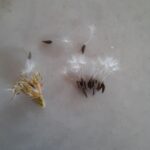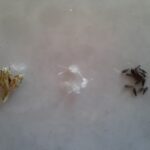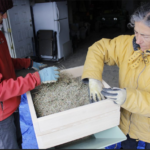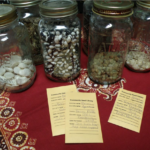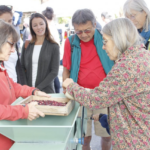4.6 Seed Saving
Learn to Save Seeds
Saving the seeds from productive plants on your farm can be a wonderful way to save money on seeds for following years, select for certain traits, and have crops that grow well on your property. If you are considering saving seeds, find information (like this Seed Matters – seed saving chart) about how spaced apart the plants need to be (they might cross if they are too close together), figure out which crops are in the same family and need to be spaced apart, if the plants are annuals or biennials, and choose open-pollinated seeds to use for seed saving (hybrid seeds will not be true to what you grew).
These are a few annual crops that are a bit easier to save seeds from:
- Beans/peas – after harvesting what you need, let some beans/peas dry out on the plant and collect them.
- Broccoli – let it flower and go to seed, collect seed pods
- Cilantro – after it bolts, let it go to seed, collect stalks
- Lettuce – if you see it about to bolt, let it go to seed (see below for photos)
- Tomatoes – save your favorite tomatoes and soak the seeds in water for a few days then let dry
Example: Lettuce
Of the lettuce that you’re growing, if you find there is one group of lettuce that is growing really well, let 2-3 plants go to seed; one would do, but a few is better. You can still harvest the rest of the plants. Take that seed, and let it dry. Then the next year, grow out the lettuce seed.
- Lettuce that went to seed
- Separating the seed from the chaff
- Store the lettuce seed
If you grow seed for yourself, you don’t need to worry so much about varieties crossing with each other. You will also save money on your seed order every year, and have crops that grow well on your farm. If you are growing it for yourself, it doesn’t matter if it crosses.
Biennial crops: Beets, carrots, celeriac. You can dig up the root crops (to make sure that they are not planted close to a crop of the same family, e.g. beets are related to chard, so they need to be planted far apart, but beets and carrots can be planted together), and plant them together in a new seed saving row.
Example: Carrots
Carrots are biennials, which means they go to seed in their second year. If you had carrots that did very well, you can let 4-5 carrots go to seed, and either let them keep growing, or move them into a special seed saving row so that they are not harvested by accident. In the second year, collect the seed!
Grow Seed to Sell
If you try seed saving for a few years and you would like to start an enterprise selling seeds, you will need to make a careful planting map for your field. After you choose the crops that you are saving the seed from, make sure that vegetables are planted far enough apart so that plants don’t cross. Only use open-pollinated seeds, as hybrids will produce offspring that will not be true to the parent.
There are two ways to plan your production of seeds; one is to focus on producing a large quantity of seed of a few crops, saving them for a few years to sell, and the second is to grow smaller amounts of several crops every year. Consider that you will need to take detailed records of the year each seed was produced, as your customers will want seeds with a high germination rate (which you can test the percentage of by sprouting 10 seeds, e.g. if 8 seeds of 10 sprout, you can estimate a germination rate of 80%).
Another thing to consider when starting a business is how long the seeds last. For example, carrot seeds will last 6 years, while the germination rate of onions and chard is already lower by year 2, and is too low by year 3.
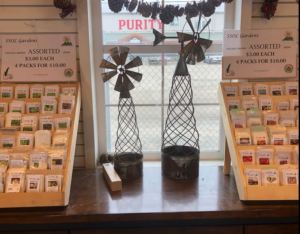
Kamloops Community Seed Library
- Daniela and Mojave cleaning seed
- Seeds at the Community Seed Library
- Cleaning seed
The Kamloops Food Policy Council runs a community seed library, where you can borrow or donate seed from. “During planting season, members take out seeds from the library and grow them. They save seeds from the plants they grow and hopefully at the end of the season, return more to the library than they initially took, thereby helping to build the collection.”
They also own a winnower and thresher that is available to people who have large amounts of seeds to save! Contact them for more details.
Seed Saving Resources
- Seed Savers Exchange – How to save your own seed
- How to Save Your Own Seeds By Diane Joubert & Bob Wildfong
- Seed Matters – Seed saving chart with plant spacing and pollination
- Saving tomato seeds // Lettuce // Bean and Pea
- Bauta Family Initiative on Seed Security


